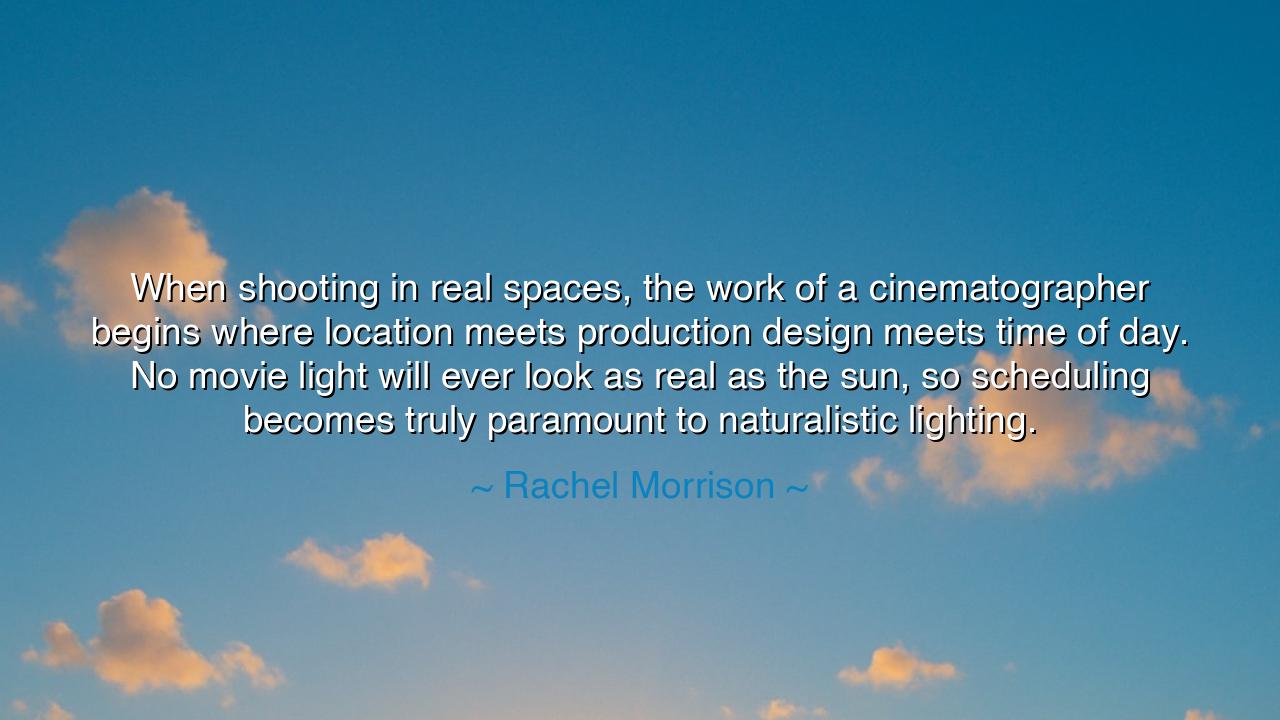
When shooting in real spaces, the work of a cinematographer
When shooting in real spaces, the work of a cinematographer begins where location meets production design meets time of day. No movie light will ever look as real as the sun, so scheduling becomes truly paramount to naturalistic lighting.






“When shooting in real spaces, the work of a cinematographer begins where location meets production design meets time of day. No movie light will ever look as real as the sun, so scheduling becomes truly paramount to naturalistic lighting.” — Rachel Morrison
Hear, O seekers of craft and bearers of vision, the words of Rachel Morrison, the artist who paints not with brush or ink, but with light itself. In her saying lies the wisdom of one who understands that true beauty does not emerge from control, but from harmony. She speaks of the sacred intersection — where location meets production design meets time of day — the trinity upon which the soul of cinematography rests. For the wise filmmaker does not seek to conquer the world with artificial light, but to collaborate with the world as it is. Morrison reminds us that art, at its highest, is not about domination, but about attunement.
The origin of these words lies in Morrison’s experience as one of the most celebrated cinematographers of her generation — the first woman ever nominated for an Academy Award in that craft, for her work on Mudbound. In that film, she did not seek to make the world look polished or contrived, but real, with the rough grace of life itself. Her images were drenched in the authenticity of natural light — the warmth of morning, the golden ache of dusk, the soft sorrow of twilight. Each frame was a collaboration between nature and design, between what the eye sees and what the heart remembers. Her quote is the distillation of this philosophy: that the sun itself is the greatest storyteller, and the artist’s duty is to meet it at the right moment.
She speaks also to a deeper truth that transcends the art of film — the eternal dance between human intention and the rhythm of the world. Just as a cinematographer must yield to the sun’s movement, so must all creators yield to timing, place, and circumstance. There is wisdom in waiting for the light. The impatient artist who forces the world to his will may achieve precision, but not truth. The patient one, who aligns her craft with the turning of the earth, will capture something eternal — something that breathes. Morrison’s insight teaches us that greatness is born not from resistance, but from synchrony with reality.
Think upon the story of the painter J. M. W. Turner, who, like Morrison, was obsessed with the language of light. Turner would chase the sun across the English coast, standing for hours before a storm, waiting for the exact instant when the clouds would part and the sky would blaze with gold. His students called him mad — but he knew that no imitation of light could rival the truth of it. And so it is with Morrison’s craft: the sun, that ancient and impartial eye, illuminates not only the world, but the artist’s humility. To work with it is to acknowledge that one’s art is part of something vaster than oneself.
In her declaration that “no movie light will ever look as real as the sun,” Morrison speaks both literally and metaphorically. Literally, she means that artificial light, however skilled its use, cannot fully reproduce the complexity of natural illumination — the soft gradients, the unseen reflections, the emotional weight of sunlight shifting through hours. But metaphorically, she reminds us that no human creation can surpass the authenticity of nature. Just as the sun nourishes life, truth nourishes art. To chase perfection through control is to miss the grace that already exists in imperfection, in fleeting beauty, in the way light touches skin or water or memory.
Thus, her emphasis on scheduling becomes a symbol for something greater — discipline. The artist must not only feel inspiration, but organize her labor in service of it. For the perfect light waits for no one; it rewards those who are ready, those who have planned, those who honor time as much as talent. In this, Morrison’s teaching mirrors the wisdom of the ancients: that the cosmos moves in cycles, and the wise must learn to move with it. Whether one paints, writes, or films, one must know when to act and when to wait — when the moment ripens and the light is right.
So let this be your lesson, O maker of images, and dreamer of worlds: work with nature, not against it. Seek the point where your will meets the world’s rhythm. Do not hurry the sunrise, nor curse the setting sun. Instead, prepare your craft so that when the light comes — whether it be the literal light of dawn or the symbolic light of inspiration — you are ready to receive it. For, as Morrison teaches, no artifice can outshine truth, and no invention can surpass the elegance of the real. When you align your vision with the world’s design, your work will glow not merely with beauty, but with life itself.






AAdministratorAdministrator
Welcome, honored guests. Please leave a comment, we will respond soon